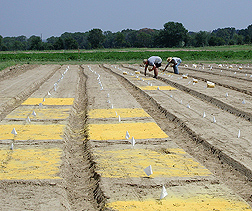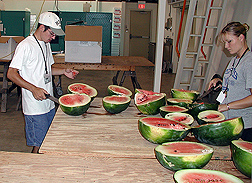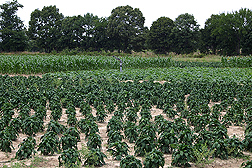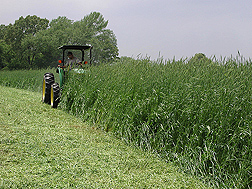Grower’s Choice
Organic and Conventional Vegetable Production Explored
|
|
More and more farmers are deciding to move from conventional to organic production. USDA’s National Organic Program was recently designed to standardize organic certification programs among all states. To help growers during the decisionmaking process, ARS scientists in Lane, Oklahoma, are gathering data on both conventional and organic methods and reporting the results.
The work is being done at the ARS South Central Agricultural Research Laboratory. Plant physiologist Vincent Russo is developing organic production systems for vegetable crops to help area growers diversify from peanut and cow-calf and forage production. ARS technician Tim Abney supplies technical support in these activities. But the researchers are working to ensure that sound management practices are used in all aspects of production, whether organic or conventional.
It’s Organic, Naturally
At the lab, once-dormant land was prepared for planting. Plots using organic methods and materials were compared to those using conventional methods and materials. Crops grown have included bell pepper, cucumber, and sweet corn.
|
|
The organic plots were farmed for 3 years—beginning in 2002—with organic practices, just as farmers using conventional methods would have to do to earn organic certification. Those plots were treated with humates (organic material high in humic acid) and corn gluten meal (CGM) to control weeds.
Russo investigated whether organic practices can produce vigorous vegetable seedlings. The first 2 years, organically grown bell pepper transplants appeared to be less vigorous than those in a conventional potting soil.
Further examination revealed that an organic fertilizer, added to a commercially available, organically certified potting medium, had to be applied at four times the label rate to produce bell pepper seedlings that were similar to those produced by methods using synthetic fertilizers and a conventional potting medium.
“At the end of the 3-year period,” Russo says, “yields of bell pepper and cucumber grown organically were as good as those grown conventionally. But organically grown sweet corn did not produce at levels similar to those using conventional methods.”
Russo and Merritt J. Taylor, an agricultural economist and director of Oklahoma State University’s Wes Watkins Agricultural Research and Extension Center, performed an economic analysis comparing organic and commercial production practices. They found that it cost 11 cents per seedling to produce bell pepper transplants with organic practices versus 8 cents per seedling using conventional methods. Three cents might not seem like much, but it adds up.
Russo concludes that it is more expensive to produce vegetables using organic rather than conventional methods. He says their findings don’t make current organic production methods impractical, but he suggests that producers consider the cost-benefit analysis.
“In the conversion to organic, there’s likely additional expense,” Russo explains. “But farmers aren’t starting from scratch, because they’ve already invested in equipment and materials. Plus, organic produce commands higher returns. Profits should rise eventually as more farmers get involved, increasing organic production and lowering the costs of producing crops.”
The researchers at Lane, and other USDA locations, are now working with an organic producer to characterize changes occurring in the soil during the transition phase.
|
|
Weeds Bite into Vegetable Farming Profits
Growers following sustainable agriculture practices need production systems that reduce use of fertilizers and pesticides. Lane agronomist Charles Webber is examining integrated vegetable production and weed-control systems using crop rotations, cover crops, and synthetic and organic herbicides. He is looking at alternative weed control methods such as CGM, pelargonic acid (a fatty acid found in plants and animals), and vinegar (acetic acid) as well as mechanized ways of applying them. Over the last few years, he has identified many vegetable-crop weeds that can be controlled with these alternative methods and is investigating their integration into various vegetable production systems.
Polypeptides, part of CGM’s protein fraction, decrease weed seedling development and plant survival by inhibiting root and shoot development during germination. CGM also supplies extra nutrition to the crop because it is about 10 percent nitrogen.
Webber and James W. Shrefler, an extension specialist at Oklahoma State in Lane, recently developed an applicator to uniformly apply CGM to the soil surface. ARS technician Buddy Faulkenberry built the device from various machine parts. Their studies demonstrated the feasibility of using equipment to precisely apply CGM, while reducing the labor involved in manual applications.
The equipment also makes it possible to apply CGM in a band on the soil surface. “The banded application protected germinating squash seeds, which were planted in a CGM-free strip, but helped control weeds where CGM was applied,” Webber says. “It’s a simple but effective process that lets us use CGM for weed control in direct-seeded crops, not just transplanted crops.” The challenge now is to determine exactly how wide to make the CGM-free strips for various vegetables, the optimum application rate, and the importance of incorporating the CGM into the soil.
Vinegar and Other Potential Weed Control Agents
They also studied vinegar, which had previously been identified as an organic herbicide. Webber says more information was needed to determine acetic acid concentrations, application volumes, and use of additives, such as orange oil or canola oil, to improve herbicide performance.
Pelargonic acid, found in many plants, is currently available in a commercial herbicide but is not yet approved as an organic herbicide. Vinegar and pelargonic acid were both found to be very effective in controlling both broadleaf and grass weeds.
“The challenge with these materials is to determine optimum application rates, delivery methods, timing, and weed and crop sensitivity,” Webber says.—By Jim Core, Agricultural Research Service Information Staff.
This research is part of Crop Protection and Quarantine (#304) and Crop Production (#305), two ARS National Programs described on the World Wide Web at www.nps.ars.usda.gov.
Vincent Russo and Charles Webber are with the USDA-ARS South Central Agricultural Research Laboratory, 911 East Highway 3, Lane, OK 74555-0159; phone (580) 889-7395, fax (580) 889-5783.
"Grower's Choice: Organic and Conventional Vegetable Production Explored" was published in the April 2006 issue of Agricultural Research magazine.










